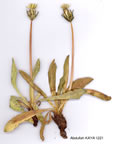| Asteraceae |
 Taraxacum crepidiforme subsp. crepidiforme |
| Taraxacum WIGGERS Taraxacum crepidiforme DC. subsp. crepidiforme DC. Ömür: Çok yıllık Yapı: ot Hayat formu: İlk çiçeklenme zamanı: 6 Son çiçeklenme zamanı: 8 Habitat: nemli alpin çayır, eriyen kar örtü yakını Minimum yükseklik: 1500 Maksimum yükseklik: 3650 Endemik: - Element: İran-Turan Türkiye dağılımı: Karasal Anadolu, KD. Anadolu Genel dağılımı: Kafkasya, K. İran, Afganistan Bulunduğu kareler :A7 A8 A9 B5 B7 B8 B9 B10 C5 C6 C9 C10 |
| T. crepidiforme DC, Prodr. 7:149 (1838). Plant glabrous or nearly so. Leaves mostly lingulate, rarely very narrowly obovate, ± non-dentate, with a pale, often ± winged petiole. Involucre dark green, outer bracts adpressed or nearly so, without gibbosities, often with a broad, white margin, but sometimes green with a narrow, black, small central field, the latter rarely very narrow and ± restricted to the central nerve. Ligules ± purple or dark violet on outside; pollen present; stigmas and styles black (exceptionally dirty yellow). Achenes straw-coloured, with a rather thick and rather short beak, or rarely beakless; pappus white. 2n = 16. Fl. 6-8. Damp alpine pastures, often near melting snow, 1500-3650 m. 1. Beak present subsp. crepidiforme 1. Beak absent subsp. kurdicum subsp. crepidiforme. Syn: T. psychrophilum Boiss., Diagn. ser. 1(11): 48 (1849); T. integrifolium C. Koch in Linnaea 23:676 (1850); T. stevenii sensu Hand.-Mazz., Monogr. Tarax. 52 (1907) quoad descr. haud typ., non (Sprengel) DC. (1838) non Leontodon stevenii Sprengel(l826); T. litvinowii Schischkin in Grossh., Fl. Kavk. 4:250 (1934). Ic: Hand.-Mazz., op. cit. t. 2 f. 4, t. 4 f. 9; Fl. URSS 29: t. 25 f. 2 (1964). Type: [Turkey] in Asiae minoris Alpibus Lazistanicis, Aucher 3546 (holo. G!). Inner & N.E. Anatolia. Alischeri Chan, 1829 m, Kotschy 644! A7 Giresun: Eğribel pass, above Tamdere, 2130-2350 m, Hub.-Mor. 15923! A8 Rize: Ikizdere, Cermanin Tepe above Cimil, 3100 m, D. 21066! A9 Kars: Ziyaret Da. above Yalnizçam, 2500 m, D. 30334! B5 Niğde: Hasan Da., 2700 m, D. 18958! B7 Erzincan: 25 km N. of Erzincan, 2200 m, It. Leyd. 1959:1674! B8 Erzurum: Erzurum, 1838, Ledebour! B9 Bitlis: Süphan Da., 1280 m, D. 24684! B1O Kars: d. Aralik, Büyük Ağri Da. above Serdar Bulak, 3000 m, D. 46984! C5 Niğde: above Bulgarmaden, Bal. 643! C6 Maraş: Berit Da., 2700 m, D. 20305! C9 Hakkari: Kara Da., 3505 m, D, 24428! C1O Hakkari: Sat Da. above Yüksekova, 2800 m, Duncan & Tait 58! Caucasia, N. Iran, Afghanistan. Ir.-Tur. element. Leontodon stevenii Sprengel (T. stevenii (Sprengel) DC.) is probably identical with, or at least related to T. stenolepium Hand.-Mazz., T. szovitsii van Soest and related species which are not known from Turkey. subsp. kurdicum (Hand.-Mazz. ex Náb.) van Soest in Acta Bot. Neerl. 17:487 (1968). Syn: T. paradoxum Hand.-Mazz. in Ann. Nat. Hofmus. Wien 37:457 (1913) non Somes (1907) nec Palmgren (1910); T. kurdicum Hand.-Mazz. ex Náb. in Publ. Fac. Sci. Univ. Masaryk Brno 52:52 (1925) non G.Hagl. (1939). Type: [Turkey C9] distr. Hakkari: Ğelo-Dar (Cilo Da.) dit. Ğulamerik (Cölemerik), ad tentoria aestiva Djezra, in alveolis nivalibus et in pascuis alpinis alt. 2700-2900 m, 3 ix 1910, Nábélek 3760! B9 Siirt: Meleto (Meretug) Da., 2700-3100 m, Hand.-Mazz. 2715! N. Iraq. Ir.-Tur. element. Handel-Mazzetti was very surprised to find this form without a beak, certainly a rare phenomenon in Taraxacum, known in T. glaciate Huet, T. primigenium Hand.-Mazz. and T. assemanii Blanche. A closer study of T. crepidiforme shows, however, that in this species the length of the (always short) beak is variable. Also in other characteristics T. crepidiforme is a variable species, for instance in the colour of the outer phyllaries. I have not been able to find a correlation between other characteristics and the length of the beak. Many specimens in herbaria are without achenes, which complicates a closer study. The variability of T. crepidiforme, in which I prefer to include T. kurdicum as a subspecies, is not surprising, as diploidy, and therefore probably sexuality, is found in this species. |